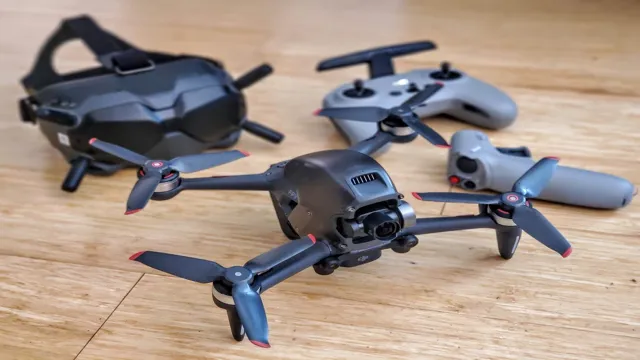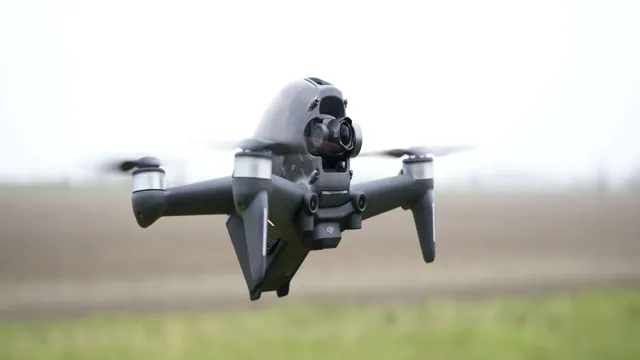
If you are a drone fanatic, you know how exciting it is to fly your DJI FPV drone. Whether you’re capturing stunning footage or simply enjoying the thrill of flying, you’re constantly striving to push the limits of your drone’s range. However, you might be experiencing interference or poor signal quality, cutting short your ultimate flying experience.
The good news is you don’t have to settle for an inadequate drone range. In this blog post, we’ll share tips on how to maximize your DJI FPV drone range so you can enjoy flying to its fullest potential. So, are you ready to take your drone flying skills to the next level?
Understanding FPV Drone Range
When it comes to understanding the range of your DJI FPV drone, it’s important to consider various factors such as interference and obstacles that may impact your signal. The range of your drone can be affected by buildings and trees, as well as other electromagnetic signals in the area. However, by using a high-quality drone and experimenting with different antennas and positioning, you can extend your range significantly.
It’s also important to consider the legal limits of your drone’s range, as flying outside of your permitted range can land you in legal trouble. With proper precautions and careful planning, you can fully enjoy the benefits of your DJI FPV drone’s range while avoiding interference and other issues.
Factors Affecting FPV Drone Range
When it comes to FPV drones, understanding the factors that affect their range is crucial for a successful flight session. The first and most important factor is the frequency band used by the drone’s transmitter and receiver. Typically, the lower the frequency, the longer the range, as it can penetrate obstacles and buildings better.
Other factors that can influence the range of an FPV drone include the power output of the transmitter, the type of antennas used, interference from other electronics and signals, and the terrain or environment where the drone is flying. It’s also worth noting that the pilot’s skill level and experience can affect the range, as a skilled pilot can maintain control of the drone even at greater distances. Ultimately, to get the best range possible, it’s important to choose reliable equipment, fly in open areas with minimal interference, and strive to improve your piloting skills.

Optimizing Your Environment
FPV Drone Range When it comes to optimizing your environment for flying FPV drones, understanding drone range is a critical factor. In simple terms, drone range refers to the maximum distance your drone can fly away from you before losing signal or video feed. This range can vary depending on several factors, including the strength of your drone’s transmitter, the type of antenna used, and obstacles in the flight path.
To optimize your drone’s range, it’s essential to choose the right equipment and ensure your environment is free from any interference. This could include removing any objects that could hamper your signal or investing in a higher quality transmitter with a stronger signal. Remember, understanding drone range can make all the difference in ensuring a successful flight.
Boosting Your FPV Drone Range
If you own a DJI FPV drone, you might be wondering how you can boost its range. The first step is to check if there are any local regulations that limit your drone’s range. Once you’ve determined that you can fly your drone farther, check your transmitter’s battery levels and make sure it’s fully charged.
Additionally, consider using an antenna booster or a directional antenna to extend your range. You can also adjust your drone’s flight mode to reduce latency and increase signal strength, which can lead to better range. Finally, try choosing a location with fewer obstacles between you and your drone, such as hills or buildings, to reduce interference and improve range.
Remember, while extending your drone’s range can be exciting, always prioritize safety and adhere to local regulations.
Upgrading Your Antennas
Upgrading the antennas on your FPV drone can significantly enhance its range and overall performance. When it comes to boosting your drone range, a higher gain antenna is a great place to start. These antennas are designed to pick up long-range signals, allowing you to fly your drone further and explore more exciting locations.
You can also opt for a directional antenna, which can focus on a specific area in front of the drone and provide a clearer signal. Another popular antenna upgrade is the circular polarized antenna, which offers better performance in crowded areas with lots of interference. Generally, upgrading your antennas can help you achieve better video quality, clearer audio, and a more responsive remote.
So if you are looking to take your FPV drone flight to the next level, consider investing in high-quality antenna upgrades that suit your specific flying needs.
Choosing the Right Frequency
Choosing the right frequency is a crucial aspect of boosting your FPV drone range. With so many frequencies to choose from, it can be hard to determine which one is best for your drone. The most common frequencies used for FPV drones are
8GHz, 4GHz, and 3GHz.
8GHz offers a great range and a clear video feed, but it is prone to interference from other electronics.
4GHz has a wider range but can suffer from signal degradation. 3GHz is less commonly used, but it offers the longest range and better penetration through obstacles.
It’s important to consider your specific needs, such as the environment you’ll be flying in and the distance you need to cover, when choosing the right frequency for your FPV drone.
Adding a Signal Booster
Adding a signal booster to your FPV drone can significantly increase its range and improve your flying experience. A signal booster works by amplifying the signal between your drone and remote control, allowing you to fly farther without losing connection. There are different types of signal boosters available, including built-in ones for some drone models or external boosters that can be attached to the antennas.
It is important to choose a booster that is compatible with your drone and remote control for optimal results. However, while a signal booster can extend your range, it is still important to follow all relevant safety laws and regulations when flying your drone. So, if you’re looking to explore new areas and improve your FPV experience, adding a signal booster could be the solution you’re looking for.
Staying Safe While Pushing the Limits
When it comes to pushing the limits with your DJI FPV drone range, it’s important to prioritize safety. Although it can be tempting to see how far your drone can go, it’s crucial to keep in mind the potential dangers and risks. You want to ensure that you’re flying within your abilities and that you’re not putting anyone or anything in harm’s way.
One great way to stay safe while still exploring the limits of your drone is to find a wide-open space where there aren’t any people or obstacles around. This gives you the opportunity to push your drone without any potential hazards. Also, make sure you have a good understanding of your drone’s range and capabilities before you start flying.
This will help you make informed decisions and prevent any accidents. By keeping safety a top priority, you can have fun and explore the limits of your DJI FPV drone range in a responsible way.
Knowing Your Limits
Knowing your limits is essential when it comes to staying safe while pushing the limits. It can be tempting to take on new challenges without fully considering the risks involved, but this can lead to serious injury or even death. Whether you’re a professional athlete, an adventurous hobbyist, or just someone who enjoys trying new things, it’s important to know your limits and respect them.
This means doing your research to understand the risks involved, being honest with yourself about your abilities and limitations, and taking steps to mitigate those risks whenever possible. By staying aware of your limits and taking steps to stay safe, you can enjoy pushing yourself to new heights without putting yourself in unnecessary danger. Remember, there is a fine line between taking risks and being reckless, so be sure to stay on the right side of that line.
Implementing Safety Measures
As humans, we are wired to push our limits, whether it’s to conquer a challenging hike, learn a new skill, or reach a new fitness goal. However, these pursuits can come with inherent risks, such as injury or illness. That’s why it’s crucial to implement safety measures to ensure that we can continue to push our boundaries without putting ourselves in harm’s way.
First and foremost, it’s essential to invest in proper gear and equipment, whether it’s a sturdy pair of shoes or a helmet for activities like cycling or skiing. Additionally, it’s crucial to listen to your body and take breaks when needed, as overexertion can lead to injury. Finally, seeking education and training around your chosen activity can ensure that you are practicing it safely and proficiently.
Remember, by implementing these safety measures, you can continue to push your limits confidently and reach your goals while keeping yourself healthy and injury-free.
Conclusion
In the world of drone racing and FPV flying, the DJI FPV drone is a real game changer. With its impressive range and top-notch performance, it has quickly become a fan favorite among both beginners and experienced pilots. Whether you’re chasing through the skies or navigating tight spaces, this drone is sure to impress.
So, whether you’re an adrenaline junkie or just looking to capture breathtaking aerial footage, the DJI FPV drone is the perfect choice for your next adventure. Trust us, once you experience the range and capabilities of this drone, you won’t want to fly anything else!”
FAQs
What is the maximum range of the DJI FPV drone?
The DJI FPV drone has a maximum range of 10 kilometers (6.2 miles), with the ability to transmit a live view from the onboard camera up to 4 kilometers (2.5 miles) away.
Can I extend the range of my DJI FPV drone?
Yes, you can use a range extender or wifi booster to extend the range of your DJI FPV drone. However, it is important to ensure that you are following regulations and maintaining line of sight with your drone at all times.
What factors can affect the range of my DJI FPV drone?
Factors that can affect the range of your DJI FPV drone include interference from surrounding buildings or objects, weather conditions such as high winds or heavy rain, and radio frequency interference from other devices.
How can I improve the signal strength and range of my DJI FPV drone?
You can improve the signal strength and range of your DJI FPV drone by ensuring that you are flying in an open area with minimal obstructions, using a range extender or wifi booster, and adjusting the transmission power settings on your drone. Additionally, using the latest firmware updates and checking for any signal interference before flying can also improve signal strength and range.





